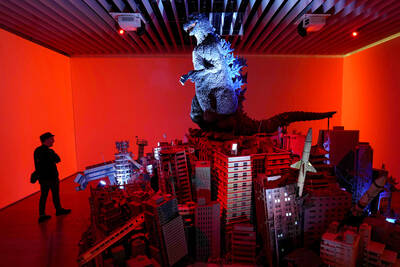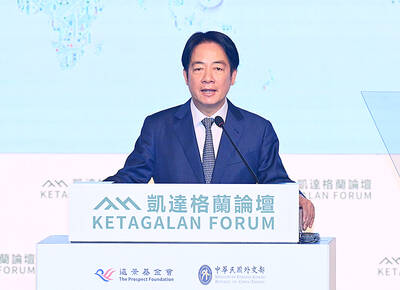Even though New Year’s Eve is on Thursday, now would be a good time to start making plans, with countdown parties in cities and counties across the country.
Wherever you are in the capital, all eyes will likely be on Taipei 101 come midnight. The building welcomes 2010 with 22,000 rounds of fireworks — 6,000 more than last year — for a show lasting 188 seconds and costing a total of NT$30 million.
But back to that important number, 2010. This also happens to be the price in NT dollars to view the fireworks from inside Taipei 101’s 89th floor observation deck. The Light Taiwan 101 party, which starts at 9:30pm, features R ’n’ B band Hot Shock, as well as lucky draw prizes that include Nokia cell phones and free ice cream coupons from Cold Stone Creamery. Tickets had not yet sold out when the Taipei Times contacted the organizer, Lion Travel (雄獅旅行社), earlier this week, but space is limited to 1,200 persons and the event sold out last year. For reservations, call (02) 2175-6611 or visit www.liontravel.com/Comm/2Dom/HotSale/101/index3.asp.
Another sky-high option for viewing the fireworks is the Miramar (美麗華) Ferris wheel in Taipei’s Neihu District, but expect long lines. Even if you don’t get a spot, there will be a concert celebration at the Miramar Entertainment Park (美麗華百樂園), at 20 Jingye 3rd Rd, Neihu Dist, Taipei City (台北市內湖區敬業三路20號), with a roster of musical guests that includes Cape No.7 (海角七號) star musician Ma Nian-hsien (馬念先) and pop duo JS. Getting to Miramar is easier than ever now that the MRT’s Wenhu Line (文湖線) has been completed (provided there are no service interruptions). The stop is Jiannan Road MRT Station (捷運劍南路站).
Or stick to Taipei tradition and see some of Taiwan’s biggest pop stars at Taipei City Hall (臺北市政府) at 1 Shifu Rd, Taipei City (台北市市府路1號). TV funnyman Hu Gua (胡瓜) and Pauline Lan (藍心湄) start warming up the crowd at 7pm, with music acts appearing throughout the evening. Performers include Wang Lee-hom (王力宏), Mayday (五月天), S.H.E and Crowd Lu (盧廣仲). The party is the city’s largest gathering and goes until 1am.
Taichung City will be sharing Wang Lee-hom with Taipei for its party, which is organized by GTV (八大) and takes place at National Taiwan Sport University Stadium (國立台灣體育大學體育場), 16, Shuangshih Rd Sec 1, Taichung City (台中市雙十路一段16號). Rainie Yang (楊丞琳) and Aska Yang (楊宗緯) are among a long list of pop stars slated to appear.
Not to be outdone by Taipei, Kaohsiung City is planning a 199-second fireworks spectacle, along with appearances and performances by a host of entertainers including Kaohsiung native Tiger Huang (黃小琥), actor Mark Chao (趙又廷), Crowd Lu (who is splitting his time with Taipei’s celebration) and Japanese pop duo Hangry and Angry. The party takes place on the block near the Dream Mall (夢時代廣場), at 789, Jhonghua 5th Rd, Kaohsiung City (高雄市中華五路789號). The main stage festivities run from 7:30pm to 1:30am, but the party continues until 3am.
Tainan is throwing a party at the city government building’s western plaza (台南市政府西側廣場) starting at 7:30pm. Keelung’s New Year’s Eve party takes place once again at Pier 3 East and Pier 4 East in the harbor district and starts at 8pm. Taitung’s Taimali Township (太麻里鄉), which was hit hard by Typhoon Morakot in August, is adding a prayer ritual to their New Year’s celebration in commemoration of their losses. A full list of New Year’s Eve parties can be found at 2010ny.emmm.tw (in Mandarin only).
If you’re attending a celebration in a major city, plan for traffic and crowd control measures. In Taipei and Kaohsiung, expect large crowds and restricted access to certain stations on the MRT, which will run extended hours. Have a safe holiday and please don’t drink and drive.

Aug. 4 to Aug. 10 When Coca-Cola finally pushed its way into Taiwan’s market in 1968, it allegedly vowed to wipe out its major domestic rival Hey Song within five years. But Hey Song, which began as a manual operation in a family cow shed in 1925, had proven its resilience, surviving numerous setbacks — including the loss of autonomy and nearly all its assets due to the Japanese colonial government’s wartime economic policy. By the 1960s, Hey Song had risen to the top of Taiwan’s beverage industry. This success was driven not only by president Chang Wen-chi’s

Last week, on the heels of the recall election that turned out so badly for Taiwan, came the news that US President Donald Trump had blocked the transit of President William Lai (賴清德) through the US on his way to Latin America. A few days later the international media reported that in June a scheduled visit by Minister of National Defense Wellington Koo (顧立雄) for high level meetings was canceled by the US after China’s President Xi Jinping (習近平) asked Trump to curb US engagement with Taiwan during a June phone call. The cancellation of Lai’s transit was a gaudy

From Godzilla’s fiery atomic breath to post-apocalyptic anime and harrowing depictions of radiation sickness, the influence of the nuclear bombings of Hiroshima and Nagasaki runs deep in Japanese popular culture. In the 80 years since the World War II attacks, stories of destruction and mutation have been fused with fears around natural disasters and, more recently, the Fukushima crisis. Classic manga and anime series Astro Boy is called “Mighty Atom” in Japanese, while city-leveling explosions loom large in other titles such as Akira, Neon Genesis Evangelion and Attack on Titan. “Living through tremendous pain” and overcoming trauma is a recurrent theme in Japan’s

As last month dawned, the Democratic Progressive Party (DPP) was in a good position. The recall campaigns had strong momentum, polling showed many Chinese Nationalist Party (KMT) lawmakers at risk of recall and even the KMT was bracing for losing seats while facing a tsunami of voter fraud investigations. Polling pointed to some of the recalls being a lock for victory. Though in most districts the majority was against recalling their lawmaker, among voters “definitely” planning to vote, there were double-digit margins in favor of recall in at least five districts, with three districts near or above 20 percent in